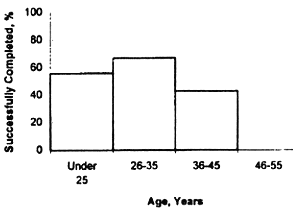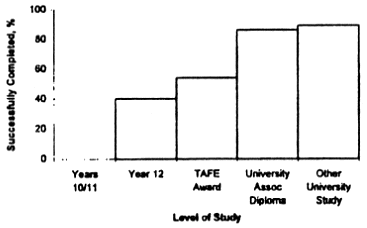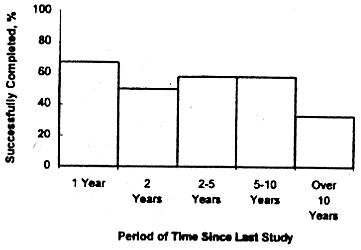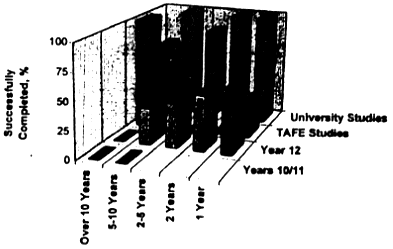
 |
This paper describes in detail the profile of external students enrolled in the first year of a Bachelor of Engineering Degree. These students come from a diversity of academic backgrounds and are primarily mature aged and in full time work. Such students although fulfilling the academic prerequisites for enrolment still have difficulties with their first year mathematics unit. It was found that students who have only achieved the maximum school qualification have more difficulties the longer they have been away from study. Students who have studied mathematics at a Technical and Further Education Institute within the last five years also experienced difficulties. However, students who have experienced university study have a greater chance of success irrespective of when these studies were completed. Many students now report that they have difficulties with mathematics and agree to the need for refreshment in the early weeks of their studies. For this refreshment, computer instruction is the preferred mode of delivery. This paper demonstrates that mathematics can be a barrier to success for many students even though access has been achieved.
To extend the opportunity of students who have traditionally not been able to access engineering because of location or employment status, in 1988 the University of Southern Queensland (USQ) introduced a professional engineering degree course by external study. This is still the only such course in Australia. It offers an opportunity for employees to follow a skill related career path as encouraged in the current industrial awards. For many industries outside metropolitan areas, such as mining and agriculture, distance education provides one of the few avenues for career change or enhancement.
USQ currently has 1200 students studying engineering externally at various levels. In the Bachelor of Engineering these students are primarily mature aged, employed full time and are the first in their family to undertake university studies (Parsons and Fowler 1994).
Students studying engineering traditionally experience a number of difficulties (Morgan 1992). There has been developing a concern that many students in science and technology based courses such as engineering, require additional support in mathematics even though the required prerequisites have been achieved. In Australia a reflection of this is the increasing number of programmes designed to help or support engineering students in the study of mathematics (Broadbridge 1994, Fuller 1994, Jackson 1994, Yasukuwa and Johnston 1994).
At USQ for the past five years on-campus students have been offered an annual short mathematics programme designed to refresh their skills in the early weeks of their first year mathematics unit. (A unit is the smallest component of a programme of study to receive a grade. In other countries it may be referred to as a subject or course.) Successful completion of the mathematics programme enhances students' chances of success in their first year mathematics unit and hence in their engineering degree. It was anticipated that because of work, other commitments and their different backgrounds, external students may have more difficulties with the study of mathematics than on-campus students.
This paper presents the results of a survey which was designed to:
Only 3 students surveyed were females. The low participation rate of females in the course probably reflects the employment practices in the engineering industry. Morgan (1992) has indicated that about 86 percent of students enrolled in the Bachelor of Engineering by external study are employed in the engineering industry.
The mathematics backgrounds of the students varied considerably. Approximately 35 percent of students had most recently studied mathematics to year 12 (matriculation level in Australia) with a further 30 percent having most recently studied mathematics as part of a University or Technical and Further Education (TAFE) Associate Diploma course. Twenty percent of students had studied mathematics as part of a previous degree programme at university. Only 9 percent of students had studied mathematics at a level below year 12 or its equivalent. Whilst the level of mathematics at which students had previously studied appeared appropriate, 42 percent of students had not studied mathematics for a period of over five years. Only 25 percent of respondents had studied mathematics within the previous 12 months.
Seventy percent of the respondents were currently enrolled in the mathematics unit offered in the first level of the Bachelor of Engineering. Of these students, 43 percent did not consider that they were prepared for the level of work in this unit and 58 percent did not consider that they were prepared for the amount of work in the unit.
When requested to rank the factors that most threatened their successful completion of the unit, 42 percent of students ranked 'unit workload' within the first two factors. 'Job commitments' was ranked within the first two factors by 32 percent of students. The 'level of study in the unit' was ranked the same as 'family commitments'. In previous studies (Morgan 1992) students have consistently ranked job and family commitments as major impediments to their success in external study. The concern expressed about the amount and level of work in the first level mathematics unit is therefore considered to be real and of great importance to external students. Seventy percent of students indicated that they found the study of the first level mathematics unit to be difficult or very difficult.

Figure 1: Relationship between age of students and successful completion of the first year mathematics unit
The type of study previously undertaken by students was a major factor in determining their chance of success in the first level mathematics unit. This is clearly shown in Figure 2. Previous study of mathematics at a university significantly enhances the students chance of success.

Figure 2: Relationship between level of previous study and successful completion of the first year mathematics unit
Contrary to expectation the period of time that had elapsed since the students last studied mathematics also did not significantly influence their chance of successfully completing the first level mathematics unit (Figure 3).

Figure 3: Relationship between period of time since last study and successful completion of the first year mathematics unit
Figure 4 shows clearly the importance of prior study of mathematics at a university. The data in this figure also indicate a progressive decline in success rate with time for grade 12 students. Yet students who completed university studies, or studies at a TAFE college more than five years ago, have been particularly successful. This may reflect a higher level of understanding of mathematics, or merely a higher motivation on the part of these students.

Figure 4: Relationship between academic background, period since last study and successful completion of the first year mathematics unit
The previously noted difficulty students had with workloads in the mathematics unit (Section 3) might make it difficult for students to complete a refreshment programme but 58 percent of students indicated that they would have time.
Students overall indicated that the computer was the preferred form of interaction with a tutor. Forty seven percent ranked it as their first or second preference. Telephone contact with a tutor at anytime was preferred by 45 percent of students and at specific times by 35 percent. Only 25 percent of students indicated teleconferencing as the preferred mode. Teleconferencing currently requires attendance at a regional study centre. Consequently with large numbers of students working full time, timing of such sessions is important. Most students preferred sessions to be on a week night. However, a surprisingly high proportion (38%) of students indicated that they would never be able to attend these sessions.
| Technology | Access | Job Access only |
| Audio Cassette | 96% | - |
| Video | 94% | - |
| Facsimile | 93% | 67% |
| PC | 94% | 18% |
| CD Rom/Multimedia | 66% | 19% |
| Printer | 96% | 27% |
| Modem | 54% | 28% |
Students not only have access to technology but many students were very familiar with software applications such as word processing, database and spreadsheet packages or specialised work systems. Only one student indicated that they had never used a computer.
Although specific groups of students at risk were not readily identifiable from this study, two trends were apparent. Where the highest level of study was Year 12, it appears that the longer the period away from study the greater the risk of failing the first year mathematics unit. Also, students who have recently completed a TAFE award seem to face a similar risk. This may be a result of the recent adoption in Australia of competency based learning programmes by the TAFE sector and the consequent changes in assessment methodology. The study did indicate that students who had previously experienced tertiary study, especially university study, were able to succeed in mathematics more than other groups. The reasons for this are as yet unclear but could be due to either a better knowledge of mathematics or a better understanding of university ways of teaching and learning.
The study demonstrates that students, especially those who have experienced school mathematics only or who have completed a TAFE award in the last five years, are in need of a programme that refreshes their mathematics knowledge and skills. These students were also prepared to devote time and effort to such a programme. They indicated that a multimedia approach which included computer mediated communication was preferred as a method of delivery to the more traditional distance education methods. Such a programme, funded by Committee for Advancement of University Teaching (CAUT) is currently under development and planned for full implementation in 1997. The introduction of the proposed programme will remove a significant barrier to students successful participation in the Bachelor of Engineering Degree by external study.
Bull, D. and Maughan, D., (1995), Information Technology Availability and Proficiency: summary of finding and survey results for the Tertiary Preparation Programrne (1995). University of Southern Queensland Internal Report.
CTEC, (1988), Review of the Discipline of Engineering. Commonwealth Tertiary Education Commission (Canberra: Australian Government Publishing Service 1988)
Fuller, M., (1994), Improving the effectiveness of mathematics education for first year Engineering students, in Committee for Advancement of University Teaching (CAUT) (Eds) Improving University Teaching 1994, National Teaching Development Projects (Canberra: Australian Government Publishing Service 1993)
Jackson, D., (1994), Workshops in first year engineering mathematics. in Par, P. and Johnston, S. (Eds) Inspiring Integration: Futures in engineering education in Australasia, Proceeding of the Sixth Annual Convention and Conference Australia Association for Engineering Education, Sydney 1994.
Morgan, M., (1992), Interim Review of the Bachelor of Engineering by External Study Offered at the University of Southern Queensland, Australia. Proceedings of the 3rd World Conference on Engineering Education, Portsmouth. 2. (Boston. Computational Mechanics Publications 1992) 15-20
Parsons, D. and Fowler, B., (1994), Student background factors and success in Engineering course at USQ. in Proceedings of HERDSA Conference, Canberra 1994
Parry, G., (1990), New Audiences and Arrangements for Engineering Higher Education. The Engineering Council in association with the Royal Society of Arts and the Training Agency. (London. The Engineering Council 1990)
Yasukawa, K. and Johnston, B., (1994), A numeracy manifesto for Engineers, Primary Teachers, Historians... a civil society - can we call it theory? Proceeding of Australian Bridging Mathematics Network Conference, University of Sydney.
| Please cite as: Taylor, J. and Morgan, M. (1996). Engineering studies by distance education - the hidden barrier: An Australian perspective. Queensland Researcher, 12(2), 25-32. http://education.curtin.edu.au/iier/qjer/qr12/taylor.html |